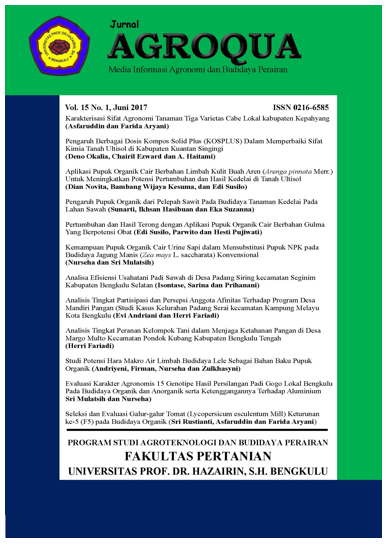PENGARUH PAKAN TAMBAHAN YANG BERBEDA TERHADAP PERTUMBUHAN KEPITING BAKAU (Scylla serrata)
DOI:
https://doi.org/10.32663/ja.v19i2.2223Keywords:
additional feed, growth, mud crabsAbstract
This study aims to determine the effect of different supplementary feeds on the growth of mud crab (Scylla serrata). This research was conducted from January 2 to March 2, 2021, at the Joint Pond Owner in Kandang Village, Kampung Melayu District, Bengkulu City. The container used is a plastic basket with a design size of 37 cm high, a circle diameter of 34 cm with a test crab size of 100-110 grams, totaling 48 tails. The design used in this study was a completely randomized design (CRD) which consisted of three treatments, namely experiment 1 (trash fish feed), Experiment 2 (mangrove snail feed), and Experiment 3 (cut chicken intestine feed) with eight replications, so that in getting twenty-four treatment units. To determine the effect or not, analysis of variance was carried out at the level of 5% and 1%, while to determine the effect of the best feed, the BNT Advanced Test (Least Significant Difference) was carried out. 5%. The parameters observed were weight growth of crabs, carapace length, carapace width, feed conversion, feed efficiency, and survival of mud crabs. The results showed that different supplementary feeding had a significant effect on the weight growth of mud crabs but had no significant effect on carapace length growth, carapace width, feed conversion, feed efficiency and survival of mangrove crabs. The best feed for the growth of mangrove crabs is chicken intestine with an initial weight of 105.2 grams and a final weight of 173.4 grams.
References
Downloads
Published
Issue
Section
License
Authors who publish with this journal agree to the following terms:
- Authors grant the journal right of first publication with the work simultaneously licensed under a Creative Commons Attribution 4.0 Internasional (CC BY 4.0) Licence that allows others to use and share the work with an acknowledgment of the work's authorship and initial publication in this journal.
- The author(s) still hold the copyright of his/her/their work and retain publishing rights without restrictions such as (but not limited to) patent right, lecture, book and reproduce the article for own purposes.
















